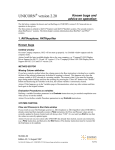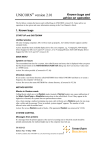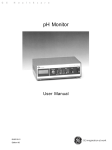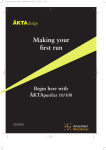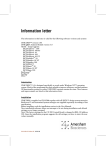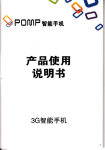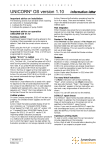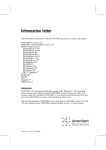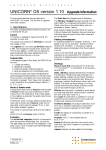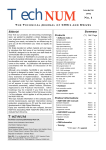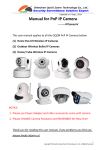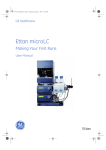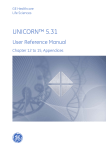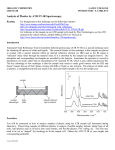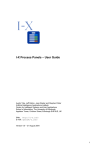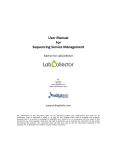Download UNICORN version 2.10 - GE Healthcare Life Sciences
Transcript
UNICORN¨ version 2.10 Known bugs and advice on operation The list below contains the known and verified bugs in UNICORN version 2.10. Some advice on operations is also given. 1. Known bugs START-UP and SHUTDOWN Untitled window On some Compaq computers, OS/2 will not start up properly. An Untitled window appears and the computer locks. Action: Install the latest available display driver for your computer, e.g. "Compaq/CL5434 Display Driver Support for OS/2 2.1X and 3.0" version 1.23 or "Compaq/QVision 1024/1280 Display Driver Support for OS/2 2.1X and 3.0" version 2.30. MAIN MENU Directory names If you create a user home directory called METHOD from within UNICORN and then try to create a Sequence, the computer will lock up. Action: Do not use the name METHOD for a home directory. (Corrected in V2.20) METHOD EDITOR Blocks in Restore mode Calling blocks which are set to Restore mode (instead of Normal mode), may cause malfunction of some instructions in the called block. Even if they appear in the logbook as executed, the system does not perform these actions. Also, when running a method containing too many calls to blocks set to Restore mode, the run stops after a while and the message "Error in method, system stopped" appears. The number of calls allowed varies with the method used. Action: Do not use Restore mode in blocks. (The parameter Restore was removed in V2.20) Blocks in BufferPrep methods If you insert a Call instruction with a variable Block name before the BufferPrep_pH instruction in a BufferPrep mode method, an operating system error message "SYS3175..." will appear when you try to save the method and the Method editor is shut down. Action: Quit UNICORN and reboot the computer. Then start UNICORN and open method editor to edit the method. Generally, if the Call instruction must appear before the BufferPrep_pH instruction, then remove the variable Block name. Otherwise you should move all Call instructions with variable Block names to after the BufferPrep_pH instruction. (Corrected in V2.20) Columns If you use a column with volume unit "l" (litre) you might get a warning message when saving the method saying that the flowrate in the method is higher than the maximum flowrate for the specified column. Action: Always set volume unit to "ml" for new columns. Also, the pre-defined columns Superdex_200_prep_grade_60/600 and Superdex_75_prep_grade_60/600, which are the only pre56-3026-17 Edition AC, 14 August 1997 56-3026-17, Edition AC, UNICORN vers. 2.10, Known bugs and advice on operation 1(6) defined columns with "l" as volume unit, should be edited to have "ml" as volume unit. (To create new columns and to edit pre-defined columns, select File/Column list in Method Editor.) (Corrected in V2.20) SYSTEM CONTROL Messages from printers If a message from the printer appears at the end of a scouting run in which the result should be printed automatically, the method might stop or the computer may lock up. Action: To avoid the most common messages, make sure that your printer is ready and has enough paper loaded. Another possible action: Do not allow any notify messages from the printer. (Error messages can usually not be turned off.) How to turn off notify messages depends on the printer. Refer to the printer User Manual. For network printers, turn off notify messages by first double-clicking on the Novell icon on the OS/2 desktop, then on NetWare Tools. Select Tools:Printer ports and double-click on the printer in the list. De-select "Notify when job is printed". Click on Capture. This change will not automatically apply the next time the computer is switched on. To make the change permanently, please contact your network administrator. How to do it depends on the login routines in your network. UV curve names UV curves are automatically given names containing the UV wavelength and this name is displayed together with the curve in System Control's curve window. However, when a run is ended, the curve name is changed back to its default name although the curve data from the run is still in the window and thus, the curve and curve name do not match. Action: No action required. UV curves are always stored in result file with correct wavelength information in the curve name. BufferPrep mode If you get a method compilation error when running a BufferPrep mode method, the method is ended but the BufferPrep recipe is still present in the instrument module. This means that during next method run, if it is NOT a BufferPrep mode method, a Pump error (3550) will occur due to inconsistency in the Pump module. This error will also occur when a BufferPrep recipe is selected manually before a method running in BufferPrep mode is started. Action: In order to abort BufferPrep mode, execute any instruction, e.g. a flow instruction, and then press the End button. (The dummy instruction must be executed for the End button to be enabled.) This action applies to all situations where you want to abort BufferPrep mode. EVALUATION Corrupt result files It might happen that a result file becomes corrupt in such a way that the Documentation information cannot be opened or printed out. In some cases the whole Evaluation module will crash as soon as the Documentation is opened. The cause is that the calibration file for the system is corrupt. If this happens, it is necessary to delete the calibration file - otherwise, all subsequent result files will be corrupt too. Once the calibration file is deleted (see Action: below) it is either replaced by the default file delivered with the strategy if such a file exists, or a new file is created. However, all calibration values and system settings are lost and a new calibration needs to be done afterwards. To make this easier, print calibration data and system settings values in the Documention of a valid result file. Action: Corrupt result files can be viewed in UNICORN V2.30. Perform following steps to delete the calibration file: · Quit UNICORN. 56-3026-17, Edition AC, UNICORN vers. 2.10, Known bugs and advice on operation 2(6) · Delete the file C:\UNICORN\LOCAL\STRATEGY\SYSTEMn\strategyname.SET, where n is "0" (zero) for the first installed system, "1" for the second, etc, and strategyname is the name of the strategy. · Shutdown and reboot the computer. Preview in File:Report When Preview has been selected in File:Report and you accidentally click outside the Preview window, the window becomes hidden (but still open) behind the UNICORN desktop. This can cause the computer to lock up at later stages. Action: Do not click outside the Preview window when open. Peak labels If Horizontal text is de-selected in Peak Label in the Chromatogram Layout box, the text is still, on some printers, printed horizontal. Furthermore, in File:Report Preview the text is not shown at all. Action: No action possible. Deleting chromatograms An operating system error message "SYS3175..." will appear if you run an evaluation procedure where the DELETE_CHROM(...) instruction is used for deleting the very same chromatogram that the procedure is run on. Action: Quit UNICORN and reboot the computer. Generally, do not use the DELETE_CHROM(...) instruction to delete the same chromatogram that the procedure is run on. (Corrected in V2.20) 56-3026-17, Edition AC, UNICORN vers. 2.10, Known bugs and advice on operation 3(6) 2. Advice on operation GENERAL Computer requirements UNICORN performance is radically improved if more RAM memory is installed on Local computers, i.e. computers connected to systems. Action: Recommended amount of RAM memory: Local computers with 1 system connected = 24 Mb Local computers with 2 or more systems connected = 32 Mb Minimum amount of RAM required is 16 Mb and is enough for Remote computers START-UP and SHUTDOWN Login and Screen Saver If a Screen Saver appears before you have had time to log in when UNICORN has been started, the login box disappears. Action: Reboot the computer. Always login immediately when the login box appears. Shutdown If UNICORN is minimised and Shutdown is selected in OS/2, a message asking to Quit UNICORN appears. When entering UNICORN, the System control window is already closed down. Action: Never select Shutdown in OS/2 when UNICORN is running. METHOD EDITOR Too many Watch instructions If a Watch instruction calls a block. e.g. named "Peak", which contains a new Watch instruction that also calls the block "Peak", the message "Too many Watches" appears in the text instruction window and a very large number of blocks will be shown. Action: The method can still be saved and run. Sample application using the System pump Most of the templates for System pump sample application (i.e. sys_f_ix, sys_v_ix, sys_f_gr, sys_v_gr) contain the variable Start_ConcB with default value 0 %B. If the start concentration is set higher than 0 %B, the column will nevertheless be washed with 12 ml of pure Eluent A after the sample injection. This may disturb the column equilibration and thus affect the separation. Action: Do not change the default value of the variable Start_ConcB in order to ensure correct sample application with the system pump. Sample application using the Sample pump Templates for Sample pump sample application, (i.e. all templates beginning with "sam_") contain SampleFlow instructions where flow rate is set to 2 ml/min. This flow rate can be too high when applicating sample volumes smaller than, approximately, 0.5 ml and reproducibility can be poor. Action: Set SampleFlow to 0.5 ml/min when applicating small sample volumes. Printout of Method Notes The default Method notes in the template methods are formatted using Tab characters to facilitate reading on the computer screen. When the Method notes are printed however, small circles ( ° ) are printed instead of Tab characters. 56-3026-17, Edition AC, UNICORN vers. 2.10, Known bugs and advice on operation 4(6) Using column Q_Sepharose_HP_60/100 If you use the default flow rate set for the pre-defined column Q_Sepharose_HP_60/100 the backpressure will be very close to the maximum pressure of the column. Action: Either decrease the default flow rate or disconnect the flow restrictor when this column is used. SYSTEM CONTROL Module calibration Calibrations made directly on €KTAª modules are logged in System Control's logbook only and not in the Calibration page of Documentation or in Audit Trail. This means that Calibration page and Audit Trail information might not be up-to-date. Action: Always calibrate €KTAª modules by using UNICORN calibration functions in System Control ActionIfPCFail setting The system setting called ActionIfPCFail defines the action to be taken in case of broken communication between PC and system. Either the method is aborted or it continues to execute. This setting is relevant for BioPilot, BioProcess and FPLC but NOT for €KTAdesign systems. Action: No action possible. In case of broken communication between PC and system, the system will ÒfreezeÓ and continue to work with same flow etc. until the communication is working again. Alarm during PumpWash or SystemWash execution If an ALARM event occurs during PumpWash, the system is Paused as it should but is Continued when PumpWash has ended. Normally, the system will remain in Pause after an ALARM. This is also true for the SystemWash instruction. Action: No action possible SystemWash If a Gradient instruction is executed during SystemWash execution, the system is washed with the selected gradient composition. Starting methods during SystemWash or PumpWash If a method run is started during SystemWash or PumpWash execution, it sometimes happens that pump instructions at breakpoints < 0.01 in the method are not executed. Action: Always press End button to abort SystemWash or PumpWash execution. Or let a wash end by itself before any method run is started. BufferPrep pH settings If a BufferPrep recipe is selected manually and BufferPrep pH is not explicitly defined by the user, a default pH value of 7.0 is used. Fractionation labels Many template methods contain fractionation blocks where fraction marks appear both from the OutletValve and the Frac-900. The second fraction in each fractionation sequence, i.e. in blocks FLOW_THROUGH_FRACTIONATION and ELUATE_FRACTIONATION respectively, may then be mislabelled. Subsequent fractions are correctly numbered however. Action: The fraction number for the first fraction in each fractionation sequence applies also to the second fraction. EVALUATION DEFAULT report format If a DEFAULT report format has been defined and File:Report is selected, chromatogram layout settings will be same as on screen and not as specified in the DEFAULT report format. 56-3026-17, Edition AC, UNICORN vers. 2.10, Known bugs and advice on operation 5(6) Action: If you want to use the DEFAULT report format chromatogram layout, you have to manually select the DEFAULT format from the list of available formats. Integration Peak labels and start/end markers shown in the curve window are always calculated from the latest integration. If an earlier calculated baseline or peaktable is selected, the peak information in the curve window is not updated. Displayed peak labels and markers and the peaktable will then not correspond. Action: Always work with the latest calculated baseline and peaktable. Integration with a non-calculated baseline If a non-calculated baseline (e.g. a curve from a blank run) is used as baseline in an integration, peak labels will not be shown in the curve window. Action: Use a calculated baseline. Evaluation procedures Each time a Peak Integration is recorded into an Evaluation procedure, a SET_COLUMN_HEIGHT(...) instruction is by default added. If the Column height parameter is never set, then the added instruction reads SET_COLUMN_HEIGHT(OFF). This means that if such a procedure is applied on a result file from a run where a column has been defined, the stored column height information is ignored and no HETP values are calculated. Correspondingly, if a Peak Integration is recorded where the Column height value is set to e.g. 1.5 cm, then this value is used whenever the Evaluation procedure is used on result files with other column heights and HETP values will be incorrect. Action: Remove any SET_COLUMN_HEIGHT(...) instructions from Evaluation procedures that you intend to use on other result files. 56-3026-17, Edition AC, UNICORN vers. 2.10, Known bugs and advice on operation 6(6)






